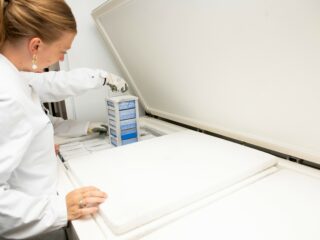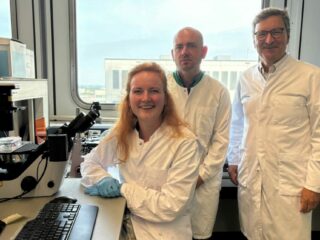Scientists use so-called models to conduct brain research. Such a model can be a laboratory animal, a cell culture, or an organoid – a kind of mini-organ in a petri dish. Thanks to new research from Erasmus MC, human brain slices can now be added to the list of research models.
The brain slices are generated from brain tissue of persons who donated their brain for research after death. The researchers cut the tissue into slices 0,35 millimeters, which is about five times the size of a hair. Researcher Seyar Rashidi developed a protocol to keep the cells and structure of the brain tissue intact for at least 14 days, an accomplishment unparalleled in the world. Rashidi will defend his PhD on April 22nd, 2025, under the supervision of promotor Georges Verjans from the HerpeslabNL at the Erasmus MC, Rotterdam.
Encephalitis
The brain slices enable new research into viruses that infect the brain. Verjans lists several examples. ‘The herpes simplex virus can cause encephalitis. With the brain slices, we can see exactly how the virus behaves in the brain over a longer period. Which cells become infected, and how do other cells respond to that? Or think about research into emerging viruses known or suspected to infect the human brain, such as Zika virus, West Nile virus, and Usutu virus. Also, the cytomegalovirus can cause damage to the brain of an unborn child. We want to learn more about how these viruses behave in the brain and thus develop better treatments.’
Rashidi adds that the new model offers the possibility of testing antiviral drugs and therapies. ‘That gives us an idea of how drugs will work in humans. Which drugs are effective against which viruses and what are the side effects?’ Verjans is enthusiastic. ‘It is spectacular that we can keep brain tissue alive for so long. This will provide many new insights.’

The special thing about the long-lasting brain slices is that they fill gaps left by other models. The missing piece, as the researchers at Erasmus MC call their new model. For example, these brain slices contain all cell types found in the brain, unlike cell cultures that contain only one of two types of cells. There are even immune cells in them, the microglia, which are absent in organoids. And they are made from human brains, which makes the step from the laboratory to the patient smaller – a drawback of animal research.
According to Verjans and Rashidi, the brain slices are not a replacement but an enrichment of the existing arsenal of models for brain research. ‘One model is usually not enough, and no model is perfect. All models have advantages and disadvantages, including the brain slices. You choose which model can best be used depending on the research question. For example, you can test something in a mouse model and then more easily check with the brain slices whether it will work in humans before transitioning to patients.’
Biomedical research
Through biomedical research, we work to understand basic biological and medical principles. This research is at the heart of medical progress and lays the foundation for innovations that improve care. As stated in Strategy28, Erasmus MC’s strategic plan.



